Wavelength-Tunable Pulsed Cylindrical Vector Beams in a 1.7-μm Mode-Locking Thulium-Doped All-Fiber Laser
Abstract
:1. Introduction
2. Experimental Setup
3. Results and Discussions
4. Conclusions
Author Contributions
Funding
Data Availability Statement
Conflicts of Interest
References
- Anderson, R.R.; Farinelli, W.; Laubach, H.; Manstein, D.; Yaroslavsky, A.N.; Gubeli, J.; Jordan, K.; Neil, G.R.; Shinn, M.; Chandler, W.; et al. Selective photothermolysis of lipid-rich tissues: A free electron laser study. Lasers Surg. Med. 2006, 38, 913–919. [Google Scholar] [CrossRef] [PubMed]
- Alexander, V.V.; Ke, K.; Xu, Z.; Islam, M.N.; Freeman, M.J.; Pitt, B.; Welsh, M.J.; Orringer, J.S. Photothermolysis of sebaceous glands in human skin ex vivo with a 1708 nm Raman fiber laser and contact cooling. Lasers Surg. Med. 2011, 43, 470–480. [Google Scholar] [CrossRef] [PubMed]
- Sordillo, L.A.; Pu, Y.; Pratavieira, S.; Budansky, Y.; Alfano, R.R. Deep optical imaging of tissue using the second and third near-infrared spectral windows. J. Biomed. Opt. 2014, 19, 056004. [Google Scholar] [CrossRef] [PubMed]
- Horton, N.G.; Wang, K.; Kobat, D.; Clark, C.G.; Wise, F.W.; Schaffer, C.B.; Xu, C. In vivo three-photon microscopy of subcortical structures within an intact mouse brain. Nat. Photonics 2013, 7, 205–209. [Google Scholar] [CrossRef]
- Yamanaka, M.; Teranishi, T.; Kawagoe, H.; Nishizawa, N. Optical coherence microscopy in 1700 nm spectral band for high-resolution label-free deep-tissue imaging. Sci. Rep. 2016, 6, 31715. [Google Scholar] [CrossRef]
- Chong, S.P.; Merkle, C.W.; Cooke, D.F.; Zhang, T.; Radhakrishnan, H.; Krubitzer, L.; Srinivasan, V.J. Noninvasive, in vivo imaging of subcortical mouse brain regions with 1.7 μm optical coherence tomography. Opt. Lett. 2015, 40, 4911–4914. [Google Scholar] [CrossRef]
- Xu, C.; Wise, F.W. Recent Advances in Fiber Lasers for Nonlinear Microscopy. Nat. Photonics 2013, 7, 875–882. [Google Scholar] [CrossRef]
- Wang, P.; Wang, H.W.; Sturek, M.; Cheng, J.X. Bond-selective imaging of deep tissue through the optical window between 1600 and 1850 nm. J. Biophotonics 2012, 5, 25–32. [Google Scholar] [CrossRef]
- Daniel, J.M.; Simakov, N.; Tokurakawa, M.; Ibsen, M.; Clarkson, W.A. Ultra-short wavelength operation of a thulium fibre laser in the 1660–1750 nm wavelength band. Opt. Express 2015, 23, 18269–18276. [Google Scholar] [CrossRef]
- Szewczyk, O.; Pala, P.; Tarnowski, K.; Olszewski, J.; Senna Vieira, F.; Lu, C.; Foltynowicz, A.; Mergo, P.; Sotor, J.; Sobon, G.; et al. Dual-Wavelength Pumped Highly Birefringent Microstructured Silica Fiber for Widely Tunable Soliton Self-Frequency Shift. J. Light. Technol. 2021, 39, 3260–3268. [Google Scholar] [CrossRef]
- Fang, X.; Wang, Z.; Zhan, L. Efficient generation of all-fiber femtosecond pulses at 1.7 μm via soliton self-frequency shift. Opt. Eng. 2017, 56, 046107. [Google Scholar] [CrossRef]
- Li, J.; Li, H.; Wang, Z. Application of Hollow-Core Photonic Crystal Fibers in Gas Raman Lasers Operating at 1.7 μm. Crystals 2021, 11, 121. [Google Scholar] [CrossRef]
- Khegai, A.; Melkumov, M.; Riumkin, K.; Khopin, V.; Firstov, S.; Dianov, E. NALM-based bismuth-doped fiber laser at 1.7 μm. Opt. Lett. 2018, 43, 1127–1130. [Google Scholar] [CrossRef] [PubMed]
- Firstov, S.; Alyshev, S.; Melkumov, M.; Riumkin, K.; Shubin, A.; Dianov, E. Bismuth-doped optical fibers and fiber lasers for a spectral region of 1600–1800 nm. Opt. Lett. 2014, 39, 6927–6930. [Google Scholar] [CrossRef]
- Zhang, L.; Zhang, J.; Sheng, Q.; Fu, S.; Shi, W.; Yao, J. High-efficiency Thulium-doped fiber laser at 1.7 μm. Opt. Laser Technol. 2022, 152, 108180. [Google Scholar] [CrossRef]
- Quan, X.; Ma, R.; Wu, H.; Yong Bai, Z.; Yuan Fan, D.; Liu, J. Low threshold and high spectral purity 1.7 μm random fiber laser based on hybrid gain. Opt. Laser Technol. 2022, 155, 108410. [Google Scholar] [CrossRef]
- Xiao, X.; Guo, H.; Yan, Z.; Wang, H.; Xu, Y.; Lu, M.; Wang, Y.; Peng, B. 3 W narrow-linewidth ultra-short wavelength operation near 1707 nm in thulium-doped silica fiber laser with bidirectional pumping. Appl. Phys. B 2017, 123, 135. [Google Scholar] [CrossRef]
- Noronen, T.; Firstov, S.; Dianov, E.; Okhotnikov, O.G. 1700 nm dispersion managed mode-locked bismuth fiber laser. Sci. Rep. 2016, 6, 24876. [Google Scholar] [CrossRef]
- Li, C.; Shi, J.; Gong, X.; Kong, C.; Luo, Z.; Song, L.; Wong, K.K.Y. 1.7 μm wavelength tunable gain-switched fiber laser and its application to spectroscopic photoacoustic imaging. Opt. Lett. 2018, 43, 5849–5852. [Google Scholar] [CrossRef]
- Emami, S.D.; Dashtabi, M.M.; Lee, H.J.; Arabanian, A.S.; Rashid, H.A.A. 1700 nm and 1800 nm band tunable thulium doped mode-locked fiber lasers. Sci. Rep. 2017, 7, 12747. [Google Scholar] [CrossRef]
- Chen, S.; Chen, Y.; Liu, K.; Sidharthan, R.; Li, H.; Chang, C.J.; Wang, Q.J.; Tang, D.; Yoo, S. All-fiber short-wavelength tunable mode-locked fiber laser using normal dispersion thulium-doped fiber. Opt. Express 2020, 28, 17570–17580. [Google Scholar] [CrossRef] [PubMed]
- Wang, X.; Song, Y.; Pang, F.; Li, Y.; Zhang, Q.; Yang, Y.; Chang, B.; Ju, Y. All-Fiber Cylindrical Vector Beams Multiplexing Through a Mode-Selective Coupler. IEEE J. Quantum Electron. 2019, 55, 1–8. [Google Scholar] [CrossRef]
- Yan, L.; Kristensen, P.; Ramachandran, S. Vortex fibers for STED microscopy. APL Photonics 2019, 4, 022903. [Google Scholar] [CrossRef]
- Yang, J.; Liu, H.; Wen, J.; Chen, L.; Shang, Y.; Chen, N.; Huang, S.; Wang, T.; Pang, F. Cylindrical vector modes based Mach-Zehnder interferometer with vortex fiber for sensing applications. Appl. Phys. Lett. 2019, 115, 051103. [Google Scholar] [CrossRef]
- Xie, Z.; Gao, S.; Lei, T.; Feng, S.; Zhang, Y.; Li, F.; Zhang, J.; Li, Z.; Yuan, X.J.P.R. Integrated (de)multiplexer for orbital angular momentum fiber communication. Photonics Res. 2018, 6, 743. [Google Scholar] [CrossRef]
- Forbes, A.; Dudley, A.; McLaren, M. Creation and detection of optical modes with spatial light modulators. Adv. Opt. Photonics 2016, 8, 200–227. [Google Scholar] [CrossRef]
- Thirugnanasambandam, M.P.; Senatsky, Y.; Ueda, K.-i. Generation of radially and azimuthally polarized beams in Yb:YAG laser with intra-cavity lens and birefringent crystal. Opt. Express 2011, 19, 1905–1914. [Google Scholar] [CrossRef]
- Qi, J.; Wang, W.; Shi, B.; Zhang, H.; Shen, Y.; Deng, H.; Pu, W.; Liu, X.; Shan, H.; Ma, X.; et al. Concise and efficient direct-view generation of arbitrary cylindrical vector beams by a vortex half-wave plate. Photonics Res. 2021, 9, 803. [Google Scholar] [CrossRef]
- Liu, T.; Chen, S.-P.; Hou, J. Selective transverse mode operation of an all-fiber laser with a mode-selective fiber Bragg grating pair. Opt. Lett. 2016, 41, 5692–5695. [Google Scholar] [CrossRef]
- Li, L.; Wang, M.; Liu, T.; Leng, J.; Zhou, P.; Chen, J. High-power, cladding-pumped all-fiber laser with selective transverse mode generation property. Appl. Opt. 2017, 56, 4967–4970. [Google Scholar] [CrossRef]
- Li, Y.; Hao, X.; An, Y.; Zhu, Y.; Yao, T.; Zeng, X.; Zhou, P. Hundred-watt level high-order mode all-fiberized random distributed feedback Raman fiber laser with high mode purity. Chin. Opt. Lett. 2023, 21, 021406. [Google Scholar] [CrossRef]
- Wang, S.; Liu, X.; Wang, H.; Hu, G. High-order mode fiber laser based on few-mode fiber gratings. Opt. Laser Technol. 2022, 155, 108416. [Google Scholar] [CrossRef]
- Chen, R.; Wang, J.; Zhang, X.; Wang, A.; Ming, H.; Li, F.; Chung, D.; Zhan, Q. High efficiency all-fiber cylindrical vector beam laser using a long-period fiber grating. Opt. Lett. 2018, 43, 755–758. [Google Scholar] [CrossRef]
- Wan, H.; Wang, J.; Shen, Z.; Chen, Y.; Zhang, Z.; Wang, P.; Zhang, L. All fiber actively Q-switched Yb-doped laser with radially/azimuthally polarized beam generation. Laser Phys. Lett. 2018, 15, 095102. [Google Scholar] [CrossRef]
- Wang, L.; Xu, J.; Lu, J.; Teng, L.; Luo, Z.; Pang, F.; Zeng, X. 3 W average-power high-order mode pulse in dissipative soliton resonance mode-locked fiber laser. Nanophotonics 2021, 10, 3527–3539. [Google Scholar] [CrossRef]
- Wan, H.; Wang, J.; Zhang, Z.; Cai, Y.; Sun, B.; Zhang, L. High efficiency mode-locked, cylindrical vector beam fiber laser based on a mode selective coupler. Opt. Express 2017, 25, 11444–11451. [Google Scholar] [CrossRef] [PubMed]
- Liu, X.; Zhang, Y.; Dong, Z.; Lv, J.; Dai, C.; Luo, J.; Lu, Y.; Ma, X.; Lin, J.; Yao, P.; et al. High-power cylindrical vector beam fiber laser based on an all-polarization-maintaining structure. Opt. Express 2022, 30, 27123–27131. [Google Scholar] [CrossRef]
- Huang, M.; Wu, J.; Hong, J.; Lei, H.; Zhao, C.; Chen, Y.; Fan, D. High energy switchable pulsed High-order Mode beams in a mode-locking Raman all-fiber laser with high efficiency. Opt. Express 2021, 29, 40538–40546. [Google Scholar] [CrossRef]
- Wu, J.; Lai, Z.; Zhou, Y.; Xie, Y.; Lei, H.; Liu, D.; Li, N.; Zhao, C.; Fan, D.; Chen, Y. High Energy Singular Beams Generation From a Dissipative Soliton Resonance Raman Fiber Laser. J. Light. Technol. 2023, 41, 5091–5096. [Google Scholar] [CrossRef]
- Xie, Y.; Long, R.; Ma, Z.; Shi, Y.; Hong, J.; Wu, J.; Zhao, C.; Fan, D.; Chen, Y. 1.7 μm sub-200 fs vortex beams generation from a thulium-doped all-fiber laser. Opt. Express 2023, 31, 27858–27867. [Google Scholar] [CrossRef]
- Huang, Y.; Shi, F.; Wang, T.; Liu, X.; Zeng, X.; Pang, F.; Wang, T.; Zhou, P. High-order mode Yb-doped fiber lasers based on mode-selective couplers. Opt. Express 2018, 26, 19171–19181. [Google Scholar] [CrossRef] [PubMed]
- Zhao, A.P.; Cvetkovic, S.R.; Punjani, M. Analysis of stripe multilayer waveguides with effective index and finite element methods. IEEE J. Quantum Electron. 1992, 28, 573–579. [Google Scholar] [CrossRef]
- Özgören, K.; Ilday, F.Ö. All-fiber all-normal dispersion laser with a fiber-based Lyot filter. Opt. Lett. 2010, 35, 1296–1298. [Google Scholar] [CrossRef] [PubMed]
- Luo, X.; Tuan, T.H.; Saini, T.S.; Nguyen, H.P.T.; Suzuki, T.; Ohishi, Y. Tunable and switchable all-fiber dual-wavelength mode locked laser based on Lyot filtering effect. Opt. Express 2019, 27, 14635–14647. [Google Scholar] [CrossRef]
- Dong, Z.; Zhang, Y.; Li, H.; Tao, R.; Gu, C.; Yao, P.; Zhan, Q.; Xu, L. All-fiber cylindrical vector beams laser based on the principle of mode superposition. Opt. Laser Technol. 2021, 139, 106965. [Google Scholar] [CrossRef]
- Sun, B.; Wang, A.; Xu, L.; Gu, C.; Lin, Z.; Ming, H.; Zhan, Q. Low-threshold single-wavelength all-fiber laser generating cylindrical vector beams using a few-mode fiber Bragg grating. Opt. Lett. 2012, 37, 464–466. [Google Scholar] [CrossRef] [PubMed]
- Mao, D.; Zheng, Y.; Zeng, C.; Lu, H.; Wang, C.; Zhang, H.; Zhang, W.; Mei, T.; Zhao, J.J.A.P. Generation of polarization and phase singular beams in fibers and fiber lasers. Adv. Photonics 2021, 3, 014002. [Google Scholar] [CrossRef]
- Liu, S.; Yan, F.; Ting, F.; Zhang, L.; Bai, Z.; Han, W.; Zhou, H. Multi-Wavelength Thulium-Doped Fiber Laser Using a Fiber-Based Lyot Filter. IEEE Photonics Technol. Lett. 2016, 28, 864–867. [Google Scholar] [CrossRef]
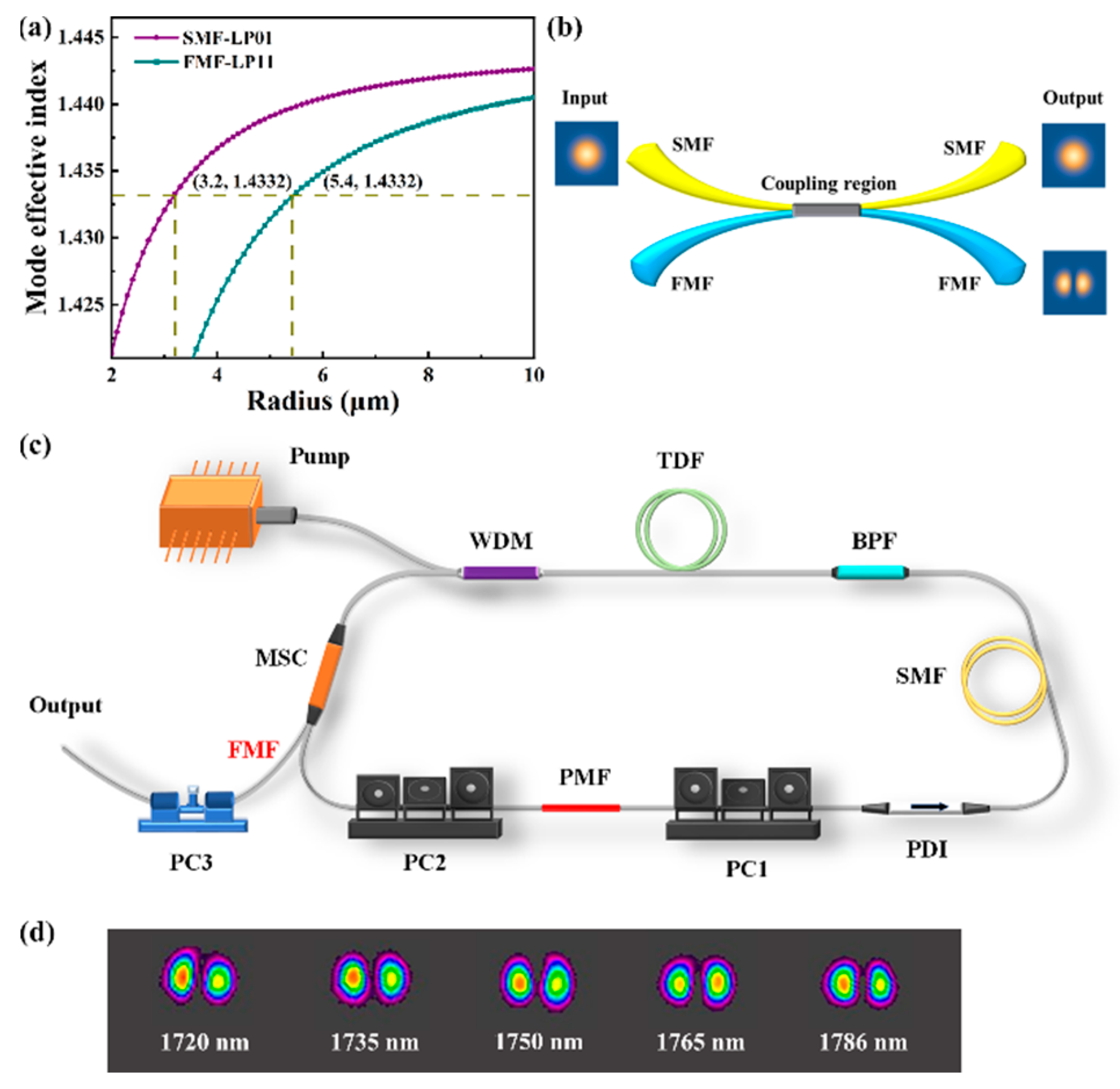

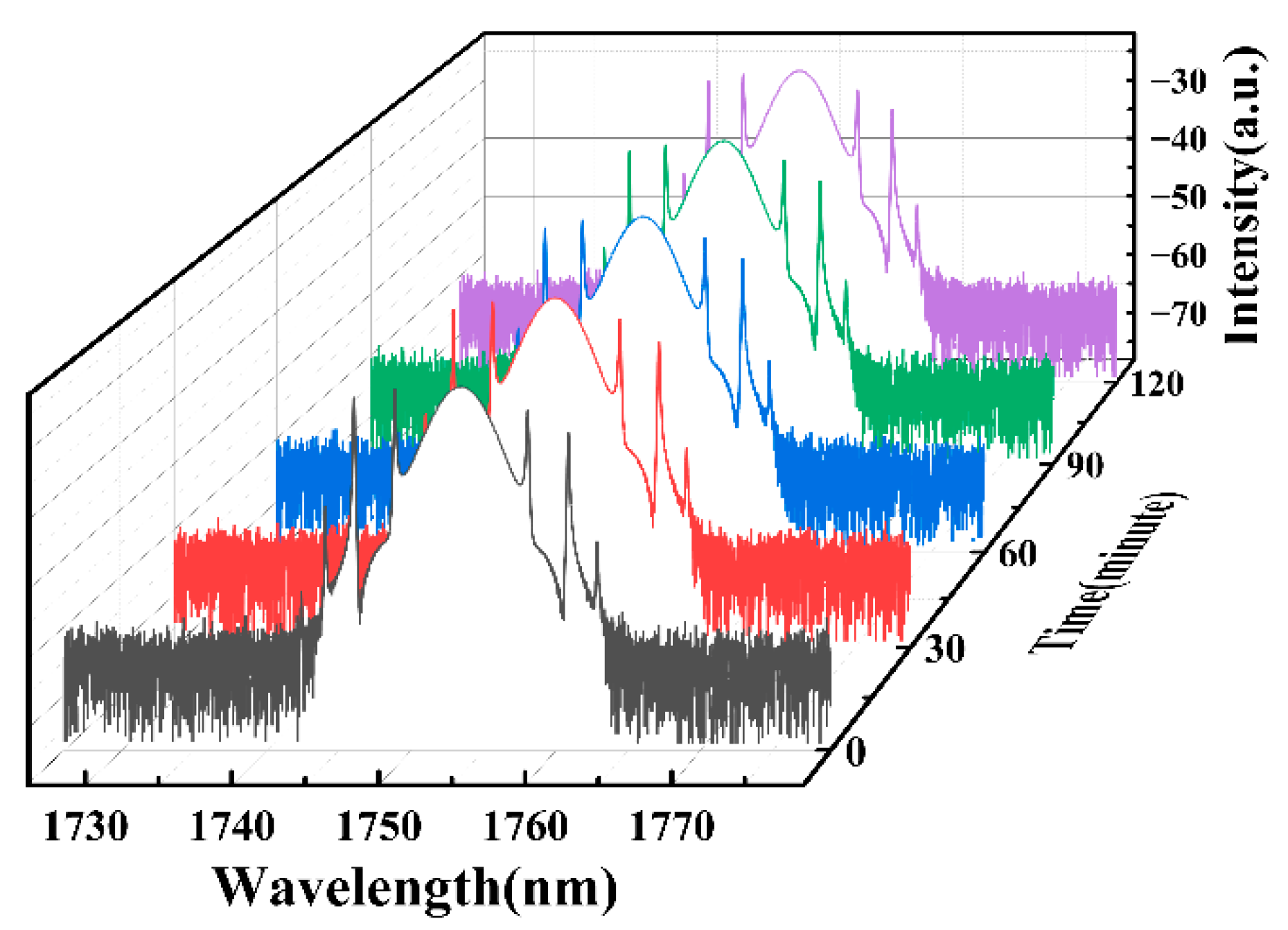
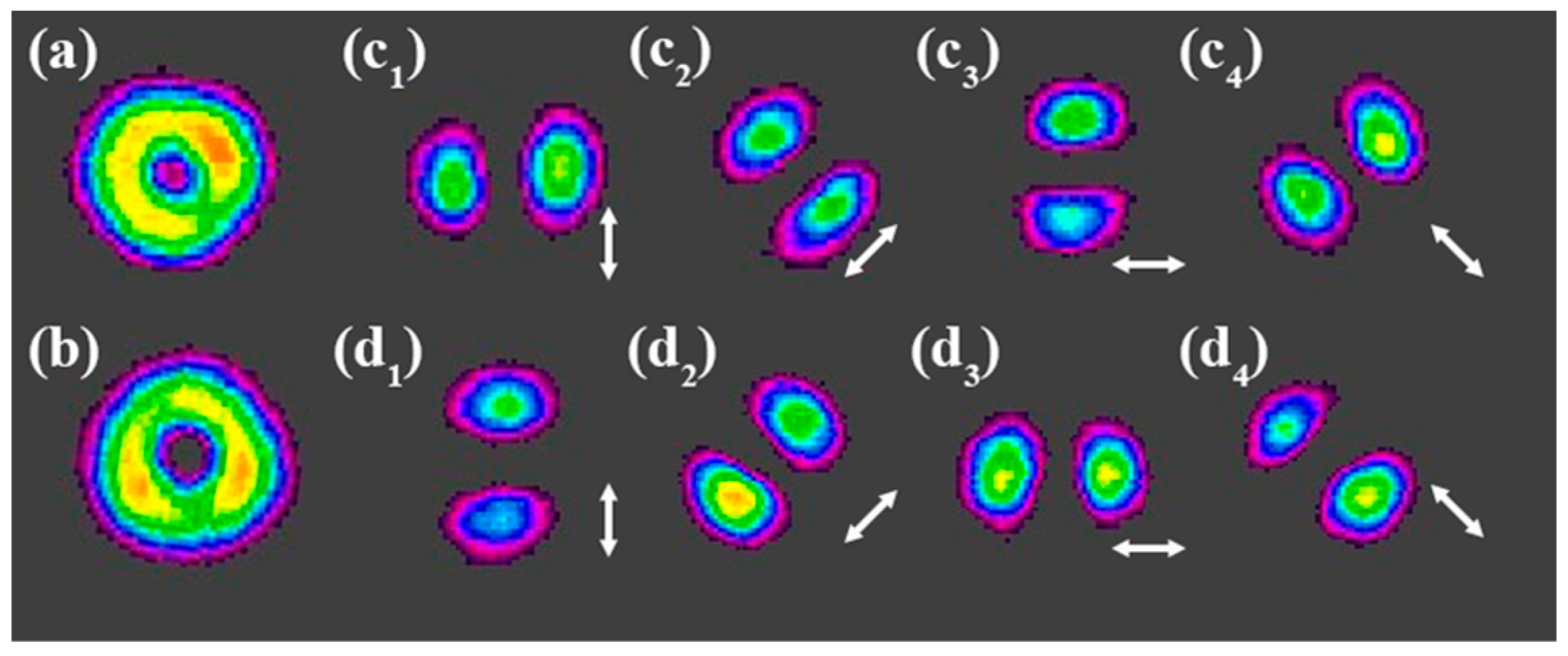
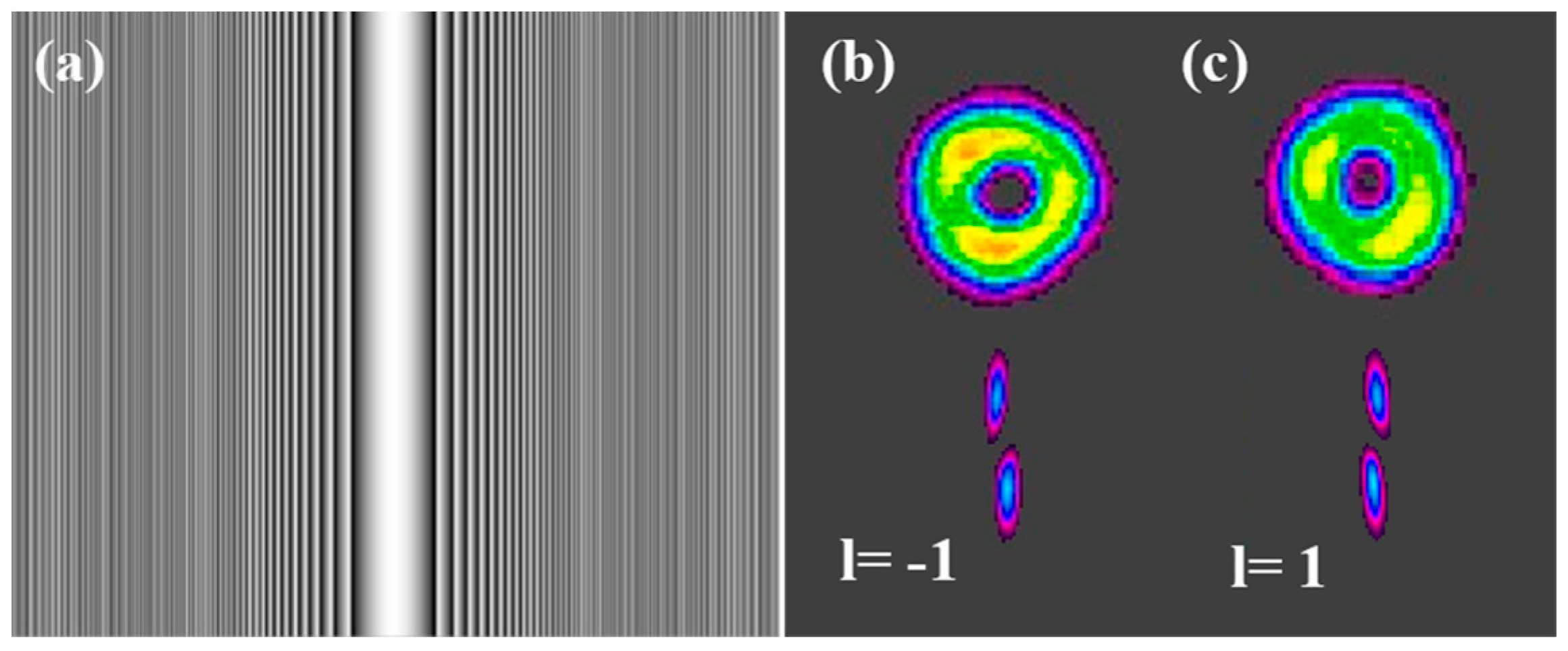
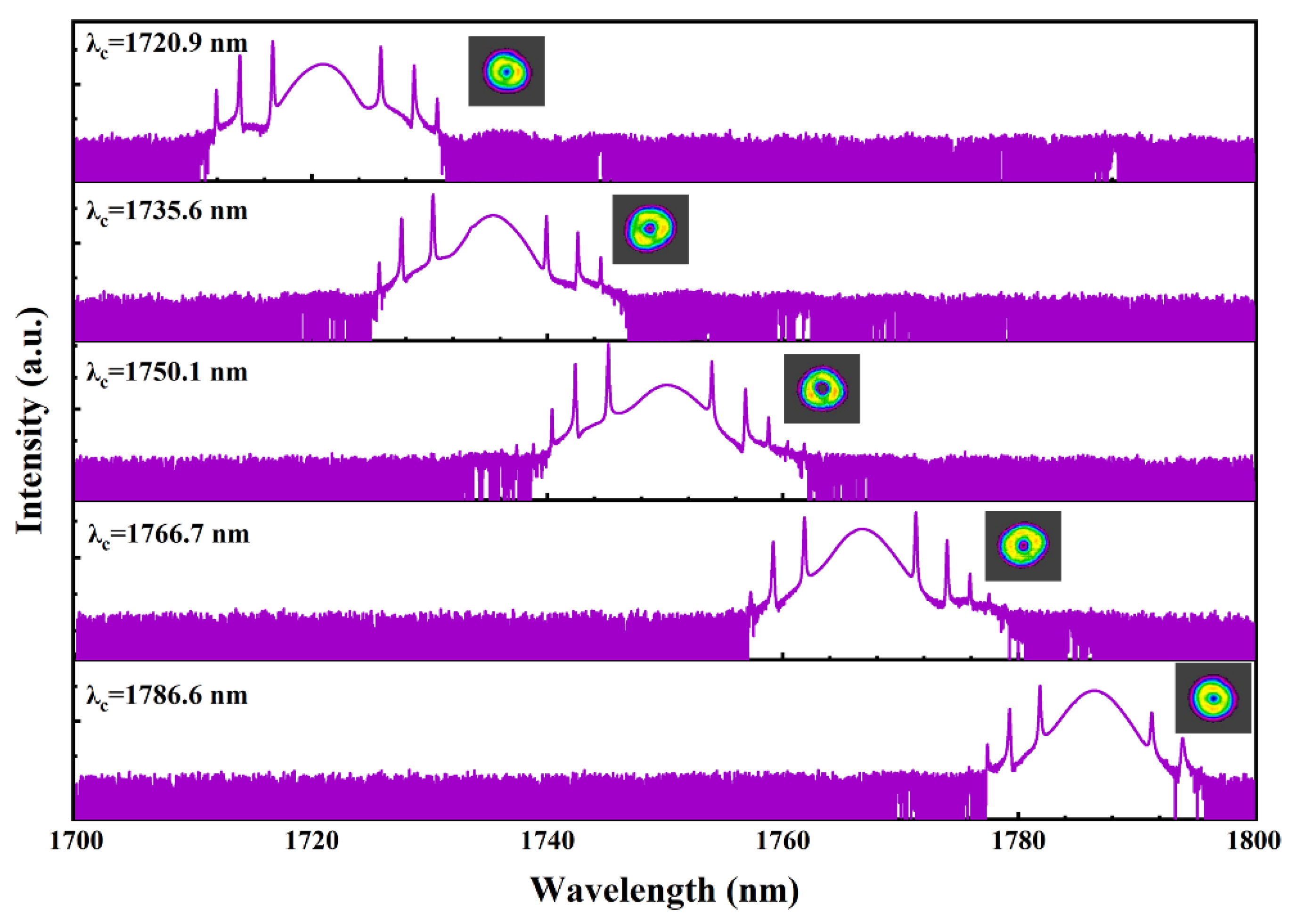
Disclaimer/Publisher’s Note: The statements, opinions and data contained in all publications are solely those of the individual author(s) and contributor(s) and not of MDPI and/or the editor(s). MDPI and/or the editor(s) disclaim responsibility for any injury to people or property resulting from any ideas, methods, instructions or products referred to in the content. |
© 2023 by the authors. Licensee MDPI, Basel, Switzerland. This article is an open access article distributed under the terms and conditions of the Creative Commons Attribution (CC BY) license (https://creativecommons.org/licenses/by/4.0/).
Share and Cite
Yang, X.; Long, R.; Xie, Y.; Wen, J.; Lv, H.; Chen, Y. Wavelength-Tunable Pulsed Cylindrical Vector Beams in a 1.7-μm Mode-Locking Thulium-Doped All-Fiber Laser. Photonics 2023, 10, 1163. https://doi.org/10.3390/photonics10101163
Yang X, Long R, Xie Y, Wen J, Lv H, Chen Y. Wavelength-Tunable Pulsed Cylindrical Vector Beams in a 1.7-μm Mode-Locking Thulium-Doped All-Fiber Laser. Photonics. 2023; 10(10):1163. https://doi.org/10.3390/photonics10101163
Chicago/Turabian StyleYang, Xiaoliang, Rufei Long, Yuhua Xie, Jiahao Wen, Hongwei Lv, and Yu Chen. 2023. "Wavelength-Tunable Pulsed Cylindrical Vector Beams in a 1.7-μm Mode-Locking Thulium-Doped All-Fiber Laser" Photonics 10, no. 10: 1163. https://doi.org/10.3390/photonics10101163
APA StyleYang, X., Long, R., Xie, Y., Wen, J., Lv, H., & Chen, Y. (2023). Wavelength-Tunable Pulsed Cylindrical Vector Beams in a 1.7-μm Mode-Locking Thulium-Doped All-Fiber Laser. Photonics, 10(10), 1163. https://doi.org/10.3390/photonics10101163




